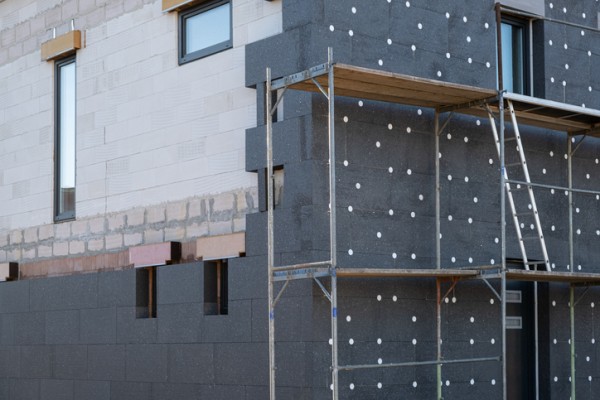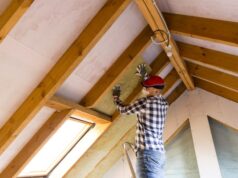
When planning a renovation or new build, sound insulation is often overlooked—but it can make a huge difference to liveability. Whether you’re reducing noise between rooms, blocking out traffic sounds, or creating a quiet home office, understanding the key acoustic ratings: Rw, Rw + Ctr and NRC. These will help you choose the right materials.
These terms are often seen on product spec sheets for things like insulation, plasterboard, glazing and doors. Here’s what they mean and why they matter.
Rw: Weighted Sound Reduction Index
Rw stands for Weighted Sound Reduction Index. It’s a laboratory-tested value that tells you how effectively a building element (like a wall, door, or window) can block airborne sound. The higher the number, the better the sound insulation.
An Rw rating is measured in decibels (dB), typically across a frequency range of 100Hz to 3150Hz. Every 1dB increase in Rw represents about a 1dB improvement in sound reduction.
For example:
A standard internal plasterboard wall might have an Rw of 35, while an acoustic-rated wall with insulation and double plasterboard could reach Rw 50 or higher.
Rw gives a good general indication of performance—but it doesn’t tell the whole story, especially when it comes to low-frequency noise.
Ctr: Low-frequency correction factor
Ctr is a correction factor applied to the Rw rating. It accounts for how well a material deals with low-frequency sounds, such as traffic rumble, bass-heavy music or machinery noise.
Low-frequency sounds are harder to block, so a product that performs well in a lab (high Rw) might not do as well in real-world conditions. Ctr is typically a negative number, and when combined with Rw, it gives a more realistic rating known as Rw + Ctr.
For example:
If a product has Rw 50 and Ctr –5, then its real-world performance for low-frequency noise is closer to 45dB.
Rw + Ctr: Real-world sound performance
When assessing acoustic performance for a renovation or new build, Rw + Ctr is usually the most useful figure. It reflects how a product performs in everyday settings, particularly when dealing with traffic, bass and other common household noise sources.
In multi-residential buildings, the National Construction Code (NCC) refers to a related rating called DnT,w + Ctr, which takes into account real-world variables like construction type and background noise. However, Rw + Ctr is still a strong guide when comparing materials.
NRC: Noise Reduction Coefficient
NRC stands for Noise Reduction Coefficient. Unlike Rw and Ctr (which measure how well materials block sound), NRC measures how well materials absorb sound within a room. It’s a number between 0 and 1, with higher numbers meaning more sound is absorbed.
For example:
- Hard surfaces like tiles or glass have NRCs close to 0—they reflect sound.
- Soft materials like acoustic ceiling tiles, carpets or curtains can have NRC ratings between 0.6 and 1—they absorb sound effectively.
High NRC materials are commonly used in home theatres, open-plan living areas, stairwells and any other space where echo and reverberation need to be controlled.
Why do these acoustic ratings matter?
Comfort and privacy
Proper sound insulation makes a home more peaceful and livable. Whether it’s keeping street noise out of bedrooms, improving privacy between rooms, or controlling echo in large open spaces, these ratings help you make the right material choices.
Meeting building regulations
The NCC outlines minimum sound insulation requirements for different building classes. For example:
- In multi-residential buildings (Class 2), separating walls and floors must achieve DnT,w + Ctr ≥ 50 for walls and ≥ 62 for floors.
- In some detached homes (Class 1), these may not be mandatory, but they’re still worth considering for comfort and resale value.
Always check local council or certifier requirements to ensure compliance.
Product selection
When comparing materials for walls, windows or floors:
- Look for high Rw and Rw + Ctr ratings if you’re trying to block noise.
- Look for high NRC ratings if you’re trying to reduce echo inside a space.
- Don’t rely on Rw alone—make sure you know the Ctr adjustment too, especially in noisy environments.
Practical tips for better acoustic design
- Use acoustic-rated products: Many manufacturers offer doors, windows, insulation and plasterboard with tested Rw and NRC values.
- Seal the gaps: Even a high-Rw wall can underperform if there are air gaps. Use acoustic sealants, door seals and proper installation techniques.
- Think in layers: Combine insulation, dense linings, and resilient mounts to improve Rw + Ctr performance.
- Design for absorption: Use rugs, curtains, upholstered furniture and acoustic panels to raise the NRC inside rooms.
Summary
| Rating | What it measures | What it means |
| Rw | Sound insulation (mid-high freq) | Higher = better at blocking sound |
| Ctr | Adjustment for low-frequency noise | Lower (less negative) = better for bass |
| Rw + Ctr | Real-world insulation performance | Most useful for assessing effectiveness |
| NRC | Sound absorption inside a room | Higher = better at reducing echo |
Whether you’re designing a quiet home office, a restful bedroom or a media room that won’t disturb the neighbours, understanding these acoustic ratings will help you build better. It’s not just about blocking noise—it’s about creating comfort.





